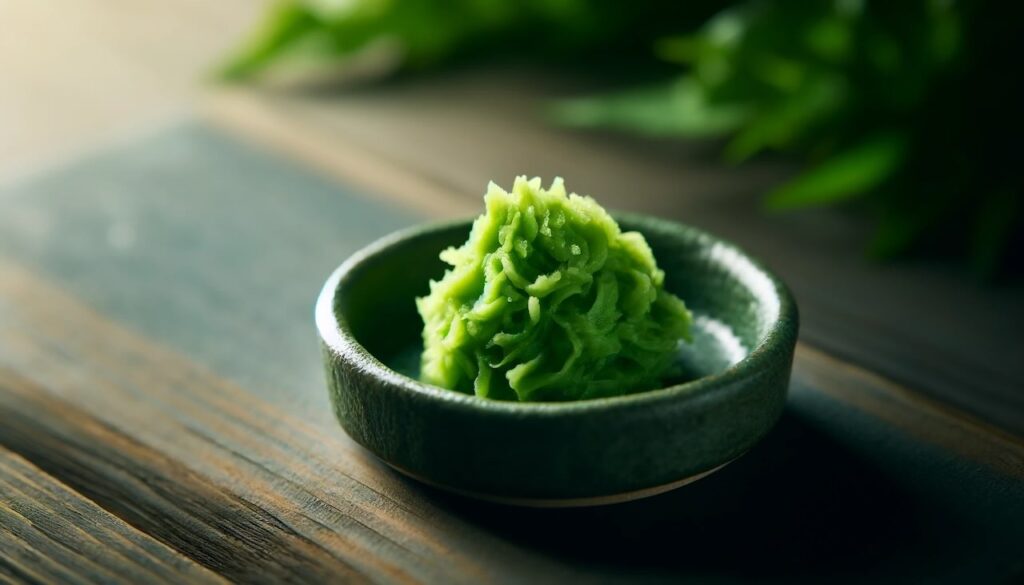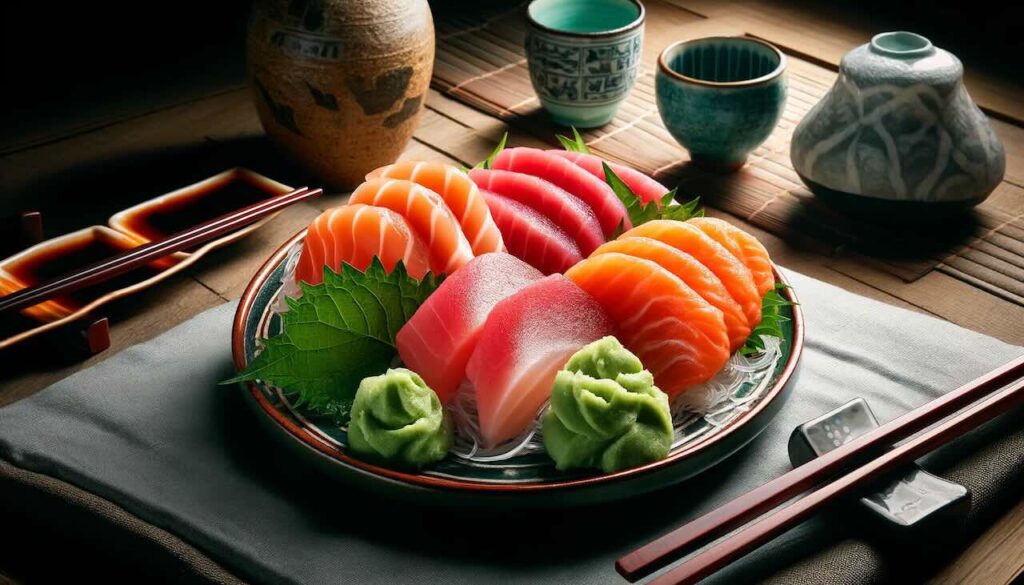Few condiments are as iconic in Japanese cuisine as wasabi. That vivid green paste, with its sharp heat and sinus-clearing zing, is far more than a sushi accompaniment — it’s a cultural treasure, a natural antimicrobial, and a nutritional powerhouse rooted in centuries of tradition.
Let’s explore the true nature of wasabi: its health benefits, cultural role, and how to enjoy it correctly.
For a complete overview of Japanese condiments, visit:
👉 The Complete Guide to Japanese Condiments: Unlocking the Flavors Behind Japan’s Culinary Mastery
What Exactly Is Wasabi?
Wasabi (山葵) comes from the rhizome of the wasabi plant (Wasabia japonica), which grows naturally along cool, clear mountain streams in Japan. Often called “Japanese horseradish”, it belongs to the Brassicaceae family, which also includes mustard and karashi.
True wasabi is rare, delicate, and highly prized for its:
- Unique heat: Sharp but fleeting, unlike the lingering burn of chili peppers.
- Fresh herbal aroma: Light, grassy, and complex.
- Anti-bacterial properties: A natural partner to raw seafood.
Unfortunately, much of the wasabi served worldwide is not genuine but rather a mixture of horseradish, mustard powder, and green food coloring.
The Health Benefits of Wasabi
Wasabi’s power goes far beyond its flavor. Its signature compound — allyl isothiocyanate (AITC) — delivers several health-promoting effects:
1. Natural Antibacterial Agent
- Inhibits harmful bacteria such as E. coli, Salmonella, and Staphylococcus aureus.
- Traditionally paired with raw fish (sashimi, sushi) for food safety long before refrigeration existed.
👉 Learn more about sashimi’s safety measures here:
The Complete Guide to Sashimi: Japan’s Art of Raw Fish and Cultural Refinement
2. Digestive Support
- Stimulates saliva production and digestive enzymes.
- Aids smoother digestion and nutrient absorption.
3. Circulation Booster
- Improves blood flow through mild vasodilation.
- Contributes to cardiovascular health when consumed moderately.
4. Anti-Inflammatory and Antioxidant Properties
- Contains vitamin C and antioxidant flavonoids.
- May help reduce inflammation and oxidative stress.
Nutritional Highlights
Though consumed in small amounts, fresh wasabi contains:
| Nutrient | Amount (per 100g of fresh rhizome) |
|---|---|
| Calories | ~109 kcal |
| Carbohydrates | ~23g |
| Fiber | ~7g |
| Protein | ~4g |
| Vitamin C | ~75mg |
| Calcium | ~120mg |
| Potassium | ~568mg |
A typical serving is tiny (about 1–2 grams), but its concentrated nutrients support overall wellness even in small doses.
Culinary Uses: Wasabi Beyond Sushi
While wasabi is most famous for its role in sushi and sashimi, it enhances many traditional Japanese dishes:
- Soba noodles: Adds sharp freshness to cold dipping sauces.
- Tempura: Cuts through fried oiliness, complementing delicate seafood.
- Grilled fish or meats: Neutralizes fishiness, highlights umami.
- Pickles and sauces: Used in dressings, miso blends, or soy-based dips.
👉 Related articles for further reading:
- Mastering the Art of Eating Sashimi: Etiquette and Manners
- The Essential Ingredients of Tempura: From Classic to Creative
Real Wasabi vs. Imitation Wasabi
| Feature | Real Wasabi | Imitation Wasabi |
|---|---|---|
| Source | Fresh wasabi rhizome | Horseradish, mustard, food coloring |
| Flavor | Mild, clean, complex | Sharp, pungent, one-dimensional |
| Availability | Rare, expensive | Common, affordable |
| Color | Pale green | Bright neon green |
If you encounter fresh-grated wasabi (hon-wasabi) at high-end sushi restaurants in Japan, savor the opportunity — its flavor is entirely different from the mass-produced versions.
Cautions and When to Limit Consumption
Despite its benefits, wasabi can irritate the stomach lining in large quantities:
- Individuals with gastritis, ulcers, or sensitive digestion should consume wasabi moderately.
- Rare allergic reactions may occur; try small amounts if tasting wasabi for the first time.
Wasabi in Japanese Food Culture
Wasabi perfectly represents Japanese culinary values:
- Harmony of flavor: Heat that supports, not dominates.
- Purity: Simple preparation to highlight natural freshness.
- Functionality: Balancing taste and health protection.
Like karashi (Japanese mustard) or shichimi togarashi (seven-spice chili blend), wasabi is part of Japan’s elegant family of condiments that marry flavor and function.
👉 Explore related condiments here:
- Karashi: Japan’s Pungent Mustard and Its Role in Japanese Cuisine
- Shichimi Togarashi: Japan’s Seven-Spice Symphony of Flavor, Health, and Culinary Tradition
Conclusion: Wasabi — More Than a Condiment
Wasabi is not just a fiery green paste—it’s a time-tested superfood embodying the harmony of Japanese culinary wisdom. With its antibacterial properties, digestive support, and nutritional value, wasabi deserves recognition both for its flavor and its health-promoting power.
Next time you enjoy sushi or soba, pause to appreciate that small dab of wasabi — it carries centuries of tradition and subtle healing power in every bite.


